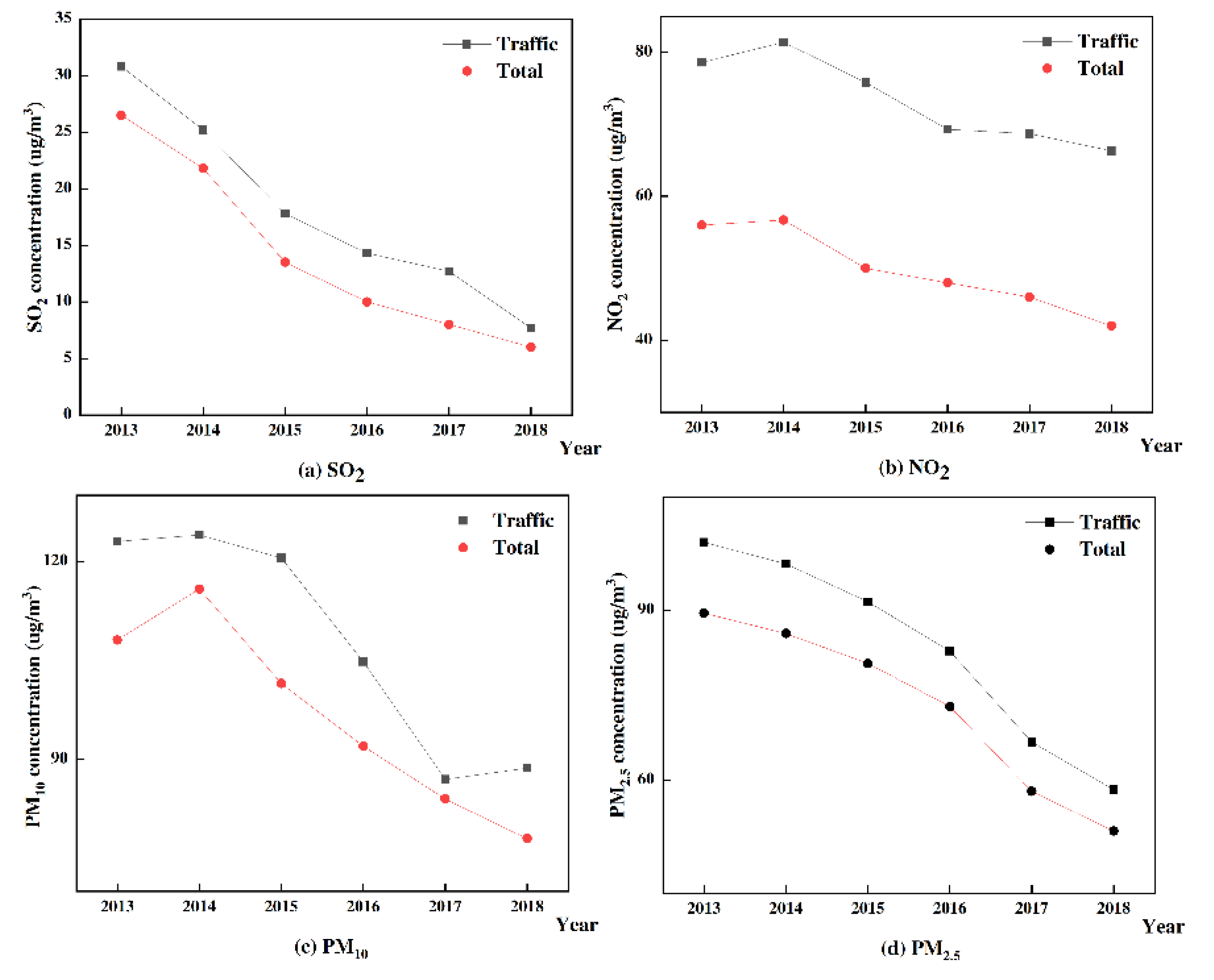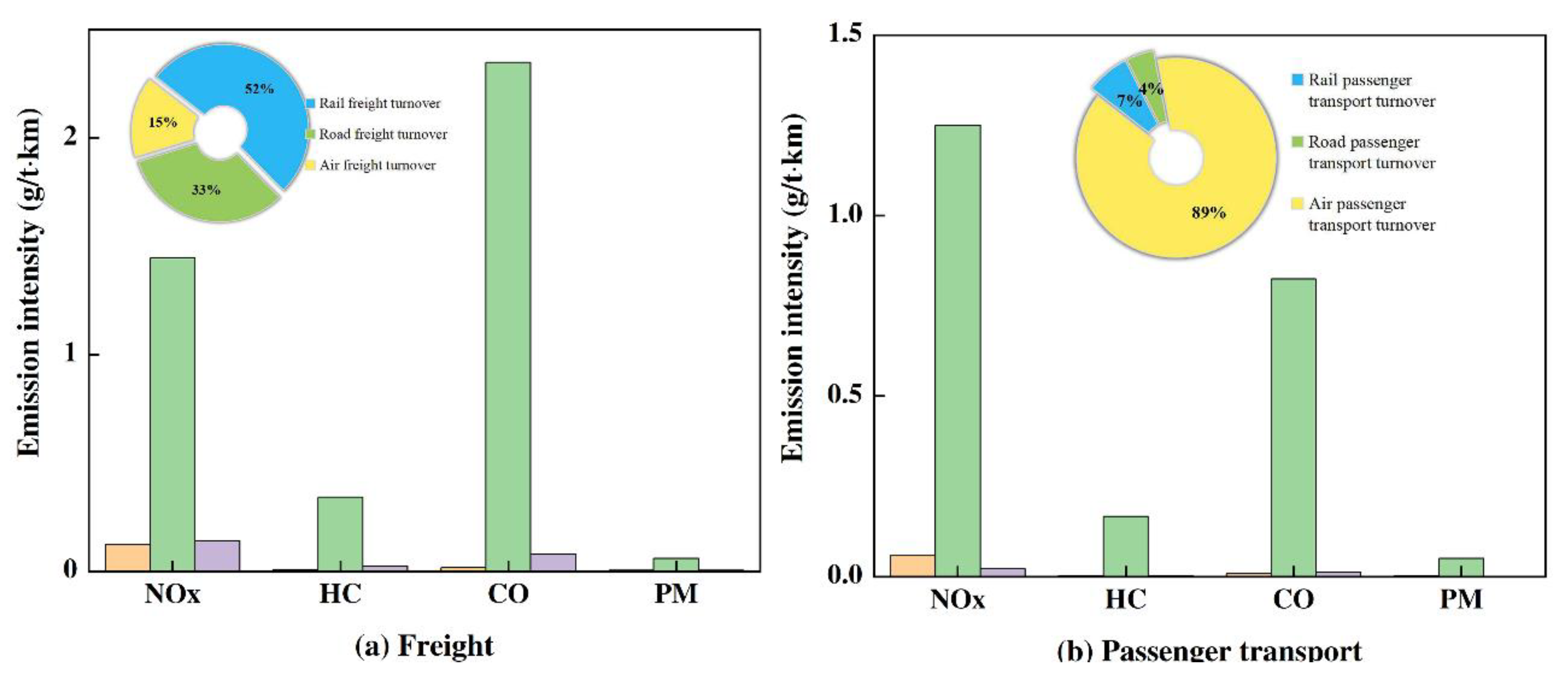Primary Air Pollutants Emissions Variation Characteristics and Future Control Strategies for Transportation Sector in Beijing, China
Abstract
1. Introduction
2. Materials and Methods
2.1. Research Objectives
2.2. Emission Evaluation Method
2.3. Traffic and Atmospheric Environment Monitoring Stations and Data
3. Results and Discussion
3.1. Changing Trends in Emissions from the Transportation Sector
3.2. Contribution to Total Emissions and Impact on Environmental Quality
3.3. Comparison of the Emissions from Different Modes of Transportation
3.4. Control Strategies for the Transportation Sector
- The structure of transportation should be improved. As can be seen from the results of variation trends in emissions from the transportation sector, the transportation structure in Beijing is relatively simple and relies too much on road transportation. The proportions of railway freight and air freight are relatively low. These two methods have relatively low pollution emission intensities. Therefore, it is necessary to adjust and optimize the transportation structure and formulate overall plans to promote the construction of multiple types of transportation network, to coordinate the use of existing railway transportation resources, and to promote the priority use of railways to transport bulk freight for key industrial enterprises, logistics parks, and industrial parks.
- The composition of road freight transportation vehicles needs to be adjusted and optimized. Diesel vehicles are still the main form of road freight transportation, emitting large amounts of NOX and PM based on calculations of emission intensity from different vehicle types. However, for short-distance freight transportation, road transportation is to some extent irreplaceable. The vehicle structure can nevertheless be adjusted to promote the replacement and update of diesel trucks that fall below the National III standard. The use of energy-saving, environmentally friendly, and new-energy trucks should be promoted by prioritizing them in related policies such as road accessibility.
- Road passenger vehicles should be electrified. According to the comparison of emissions from different modes of transportation and motor vehicle types in Section 3.3, passenger vehicles, such as buses, taxis, and coaches, greatly contribute to HC and CO emissions due to their intensive use. Increasing the replacement of these passenger vehicles by electric vehicles can reduce their pollution emissions. These types of electric vehicle models are more mature in technology, and their battery life and supporting infrastructure are constantly being improved. As the technology continues to progress, the cost is decreasing.
- The supervision and enforcement of emission standards need to be strengthened. Remote sensing monitoring, remote emission management terminals, and other methods can be used to monitor the emissions of freight transportation vehicles, thus effectively and quickly identifying excessive emissions. A closed-loop management system for maintenance and inspection should be established to ensure that vehicles with excessive emissions are repaired and rectified in a timely manner. Daily maintenance should be strengthened to ensure that emissions standards are met during actual use and to effectively reduce pollutant emissions.
4. Conclusions
Author Contributions
Funding
Conflicts of Interest
Disclaimer
References
- Takeshita, T. Global Scenarios of Air Pollutant Emissions from Road Transport through to 2050. Int. J. Environ. Res. Public Health 2011, 8, 3032–3062. [Google Scholar] [CrossRef]
- Charron, A.; Polo-Rehn, L.; Besombes, J.L.; Golly, B.; Buisson, C.; Chanut, H.; Marchand, N.; Guillaud, G.; Jaffrezo, J.L. Identification and quantification of particulate tracers of exhaust and non-exhaust vehicle emissions. Atmos. Chem. Phys. 2019, 19, 5187–5207. [Google Scholar] [CrossRef]
- Guo, X.R.; Fu, L.W.; Ji, M.; Lang, J.L.; Chen, D.S.; Cheng, S.Y. Scenario analysis to vehicular emission reduction in Beijing-Tianjin-Hebei (BTH) region China. Environ. Pollut. 2016, 216, 470–479. [Google Scholar] [CrossRef] [PubMed]
- Keyte, I.J.; Albinet, A.; Harrison, R.M. On-road traffic emissions of polycyclic aromatic hydrocarbons and their oxy- and nitri- derivative compounds measured in road tunnel environments. Sci. Total Environ. 2016, 566, 1131–1142. [Google Scholar] [CrossRef] [PubMed]
- Sun, S.D.; Jin, J.X.; Xia, M.; Liu, Y.M.; Gao, M.; Zou, C.; Wang, T.; Lin, Y.C.; Wu, L.; Mao, H.J.; et al. Vehicle emissions in a middle-sized city of China: Current status and future trends. Environ. Int. 2020, 137, 105514. [Google Scholar] [CrossRef]
- BJMEEB (Beijing Municipal Ecological Environment Bureau). Beijing Has Released the Newest Source Apportionment Results of Ambient PM2.5 Concentrations. 2018. Available online: http://www.xinhuanet.com/politics/2018-05/15/c_1122832062.html (accessed on 10 February 2020).
- Zhao, S.; Xu, Y. Exploring the Spatial Variation Characteristics and Influencing Factors of PM2.5 Pollution in China: Evidence from 289 Chinese Cities. Sustainability 2019, 11, 4751. [Google Scholar] [CrossRef]
- Li, X.; Zhang, Q.; Zhang, Y.; Zheng, B.; Wang, K.; Chen, Y.; Wallington, T.J.; Han, W.J.; Shen, W.; Zhang, X.Y.; et al. Source contributions of urban PM2.5 in the Beijing-TianjinHebei region: Changes between 2006 and 2013 and relative impacts of emissions and meteorology. Atmos. Environ. 2015, 123, 229–239. [Google Scholar] [CrossRef]
- Zhang, S.J.; Wu, Y.; Wu, X.M.; Li, M.L.; Ge, Y.S.; Liang, B.; Xu, Y.Y.; Zhou, Y.; Liu, H.; Fu, L.X.; et al. Historic and future trends of vehicle emissions in Beijing, 1998–2020: A policy assessment for the most stringent vehicle emission control program in China. Atmos. Environ. 2014, 89, 216–229. [Google Scholar] [CrossRef]
- Yang, D.Y.; Zhang, S.J.; Niu, T.L.; Wang, Y.J.; Xu, H.L.; Zhang, K.M.; Wu, Y. High-resolution mapping of vehicle emissions of atmospheric pollutants based on large-scale, real-world traffic datasets. Atmos. Chem. Phys. 2019, 19, 8831–8843. [Google Scholar] [CrossRef]
- Liu, Y.H.; Liao, W.Y.; Lin, X.F.; Li, L.; Zeng, X.L. Assessment of Co-benefits of vehicle emission reduction measures for 2015–2020 in the Pearl River Delta region China. Environ. Pollut. 2017, 223, 62–72. [Google Scholar] [CrossRef]
- Song, C.B.; Ma, C.; Zhang, Y.J.; Wang, T.; Wu, L.; Wang, P.; Liu, Y.; Li, Q.; Zhang, J.S.; Dai, Q.L.; et al. Heavy-duty diesel vehicles dominate vehicle emissions in a tunnel study in northern China. Sci. Total Environ. 2018, 637, 431–442. [Google Scholar] [CrossRef] [PubMed]
- Wang, Y.J.; Zhang, S.J.; Hao, J.M. Air pollution control in China: Progress, challenges and paths. Environ. Sci. 2019, 32, 1755–1762. [Google Scholar]
- Cheng, S.F.; Lu, F.; Peng, P. A high-resolution emissions inventory and its spatio-temporal pattern variations for heavy-duty diesel trucks in Beijing, China. J. Clean. Prod. 2020, 250, 119445. [Google Scholar] [CrossRef]
- Jia, T.; Li, Q.; Shi, W.Z. Estimation and analysis of emissions from on-road vehicles in Mainland China for the period 2011-2015. Atmos. Environ. 2018, 191, 500–512. [Google Scholar] [CrossRef]
- Jing, B.Y.; Wu, L.; Mao, H.J.; Gong, S.N.; He, J.J.; Zou, C.; Song, G.H.; Li, X.Y.; Wu, Z. Development of a vehicle emission inventory with high temporal-spatial resolution based on NRT traffic data and its impact on air pollution in Beijing-Part 1: Development and evaluation of vehicle emission inventory. Atmos. Chem. Phys. 2016, 16, 3161–3170. [Google Scholar] [CrossRef]
- Gately, C.K.; Hutyra, L.R.; Peterson, S.; Wing, I.S. Urban emissions hotspots: Quantifying vehicle congestion and air pollution using mobile phone GPS data. Environ. Pollut. 2017, 229, 496–504. [Google Scholar] [CrossRef]
- Wang, M.L.; Li, S.Y.; Zhu, R.C.; Zhang, R.Q.; Zu, L.; Wang, Y.J.; Bao, X.F. On-road tailpipe emission characteristics and ozone formation potentials of VOCs from gasoline, diesel and liquefied petroleum gas fueled vehicles. Atmos. Environ. 2020, 223, 117294. [Google Scholar] [CrossRef]
- Zhang, S.J.; Wu, Y.; Liu, H.; Huang, R.K.; Un, P.K.; Zhou, Y.; Fu, L.X.; Hao, J.M. Real-world fuel consumption and CO2 (carbon dioxide) emissions by driving conditions for light-duty passenger vehicles in China. Energy 2014, 69, 247–257. [Google Scholar] [CrossRef]
- Fameli, K.M.; Kotrikla, A.M.; Psanis, C.; Biskos, G.; Polydoropoulou, A. Estimation of the emissions by transport in two port cities of the northeastern Mediterranean, Greece. Environ. Pollut. 2020, 257, 113598. [Google Scholar] [CrossRef]
- Hatzopoulou, M.; Miller, E.J. Linking an activity-based travel demand model with traffic emission and dispersion models: Transport’s contribution to air pollution in Toronto. Transp. Res. D Transp. Environ. 2010, 15, 315–325. [Google Scholar] [CrossRef]
- Kelly, F.J.; Zhu, T. Transport solutions for cleaner air. Science 2016, 352, 934–936. [Google Scholar] [CrossRef] [PubMed]
- Vallamsundar, S.; Lin, J.; Konduri, K.; Zhou, X.; Pendyala, R.M. A comprehensive modeling framework for transportation-induced population exposure assessment. Transp. Res. D Transp. Environ. 2016, 46, 94–113. [Google Scholar] [CrossRef]
- Wu, Y.; Zhang, S.J.; Li, M.L.; Ge, Y.S.; Shu, J.W.; Zhou, Y.; Xu, Y.Y.; Hu, J.N.; Liu, H.; Fu, L.X.; et al. The challenge to NOX emission control for heavy-duty diesel vehicles in China. Atmos. Chem. Phys. 2012, 12, 9365–9379. [Google Scholar] [CrossRef]
- Fan, F.; Lei, Y. Decomposition analysis of energy-related carbon emissions from the transportation sector in Beijing. Transp. Res. Part D 2016, 42, 135–145. [Google Scholar] [CrossRef]
- BMBS (Beijing Municipal Bureau of Statistics). Beijing Statistical Yearbook. 2019. Available online: http://202.96.40.155/nj/main/2019-tjnj/zk/indexch.htm (accessed on 11 February 2020).
- Timmers, V.R.J.H.; Achten, P.A.J. Non-exhaust PM emissions from electric vehicles. Atmos. Environ. 2016, 134, 10–17. [Google Scholar] [CrossRef]
- Air Quality Expert Group. Non-Exhaust Emissions from Road Traffic. 2019. Available online: https://uk-air.defra.gov.uk/assets/documents/reports/cat09/1907101151_20190709_Non_Exhaust_Emissions_typeset_Final.pdf (accessed on 15 February 2020).
- Xue, Y.F.; Zhang, S.H.; Zhou, Z.; Wang, K.; Liu, K.Y.; Wang, X.Y.; Shi, A.J.; Xu, K.L.; Tian, H.Z. Spatio-temporal variations of multiple primary air pollutants emissions in Beijing of China, 2006–2015. Atmosphere 2019, 10, 494. [Google Scholar] [CrossRef]
- Beijing Municipal Government. Clean Air Action Plan in Beijing, 2013–2017. 2017. Available online: http://www.beijing.gov.cn/zhengce/zfwj/zfwj/szfwj/201905/t20190523_72673.html (accessed on 14 February 2020).
- Lee, S.; Hwang, T. Estimating emissions from regional freight delivery under different urban development scenarios. Sustainability 2018, 10, 1188. [Google Scholar] [CrossRef]





| Type of Transportation | Transportation Cost | Unit | |
|---|---|---|---|
| Freight | Railway | 0.18 | Dollar/ton·kilometer |
| Road | 0.07 | ||
| Air | 0.67 | ||
| Passenger | Railway | 0.07 | Dollar/person·kilometer |
| Road | 0.06 | ||
| Air | 0.11 | ||
© 2020 by the authors. Licensee MDPI, Basel, Switzerland. This article is an open access article distributed under the terms and conditions of the Creative Commons Attribution (CC BY) license (http://creativecommons.org/licenses/by/4.0/).
Share and Cite
Xue, Y.; Cao, X.; Ai, Y.; Xu, K.; Zhang, Y. Primary Air Pollutants Emissions Variation Characteristics and Future Control Strategies for Transportation Sector in Beijing, China. Sustainability 2020, 12, 4111. https://doi.org/10.3390/su12104111
Xue Y, Cao X, Ai Y, Xu K, Zhang Y. Primary Air Pollutants Emissions Variation Characteristics and Future Control Strategies for Transportation Sector in Beijing, China. Sustainability. 2020; 12(10):4111. https://doi.org/10.3390/su12104111
Chicago/Turabian StyleXue, Yifeng, Xizi Cao, Yi Ai, Kangli Xu, and Yichen Zhang. 2020. "Primary Air Pollutants Emissions Variation Characteristics and Future Control Strategies for Transportation Sector in Beijing, China" Sustainability 12, no. 10: 4111. https://doi.org/10.3390/su12104111
APA StyleXue, Y., Cao, X., Ai, Y., Xu, K., & Zhang, Y. (2020). Primary Air Pollutants Emissions Variation Characteristics and Future Control Strategies for Transportation Sector in Beijing, China. Sustainability, 12(10), 4111. https://doi.org/10.3390/su12104111





